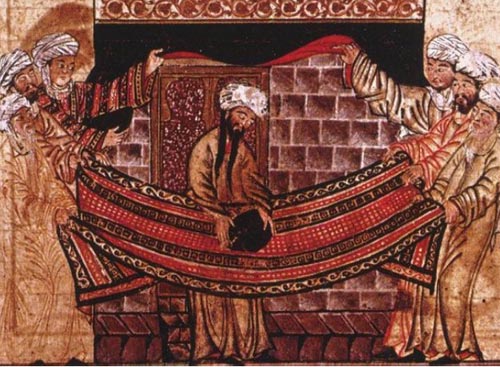
What is the Black Stone of Mecca? Is it from outer space?
Why are humans programmed to worship what is believed
to be holy relics no matter what powers they portend?
The Black Stone of Mecca, or Kaab'a Stone, is a Muslim holy relic, which according to Islamic tradition dates back to the time of Adam and Eve. It is the eastern cornerstone of the Kaaba, the ancient sacred stone building towards which Muslims pray, in the center of the Grand Mosque in Mecca, Saudi Arabia. The Stone is a dark rock, polished smooth by the hands of millions of pilgrims, that has been broken into a number of fragments cemented into a silver frame in the side of the Kaaba. Although it has often been described as a meteorite, this hypothesis is still under consideration.It is the eastern cornerstone of the Kaaba, the ancient sacred stone building towards which Muslims pray, in the center of the Grand Mosque in Mecca, Saudi Arabia.
The Stone is roughly 30 cm (12 in.) in diameter, and 1.5 meters (5 ft.) above the ground. When pilgrims circle the Kaaba as part of the Tawaf ritual of the Hajj, many of them try, if possible, to stop and kiss the Black Stone, emulating the kiss that it received from the Islamic prophet Muhammad. If they cannot reach it, they are to point to it on each of their seven circuits around the Kaaba. The Stone is broken into a number of pieces from damage which was inflicted during the Middle Ages. The pieces are held together by a silver frame, which is fastened by silver nails to the Stone.
There are various opinions as to what the Black Stone actually is. Muslims say that the Stone was found by Abraham (Ibrahim) and his son Ishmael (Ismail) when they were searching for stones with which to build the Kaaba. They recognized its worth and made it one of the building's cornerstones.
Secular historians point to the history of stone worship, and especially meteorite worship, in pre-Islamic Arabia, and say that it is likely that the Stone is a meteorite. There is no way to test this hypothesis without removing and examining the Stone, which would not be permitted by its guardians.

There is no indication as to where this stone originated, but since it pre-dates the revelation of the Holy Qur'an and Muhammad's prophethood, and even kissed, it must stem from the time of Abraham since the Hajj traditions are traceable to the patriarch of monotheism.
The Ka'bah at Mecca describes the shape of the black stone structure on a marble base which stands in the centre court of the Great Mosque, Masjidul Haram, at the centre of Mecca. It stands about 50 feet high by about 35 feet wide. Set into the eastern corner is the sacred stone. This Ka'ba is a cubed shaped temple rebuilt by Abraham and his son Ishmael. Reverently draped in black cloth throughout the year, it beckons to every Muslim of the world to come to its sacred ground.
The Ka'ba - Kaaba - is the canonical center of the Islamic world and every pious act, particularly prayer, is directed toward it. Once a year it plays host to the greatest convention of religious believers and stands ready to sanctify the Umrah traveler through the balance of the year.
The official starting point of the walk around the Kaaba, that forms the core of the holy pilgrimage, is called the hajj. During the Tawaf pilgrims kiss or touch the black stone as they circumambulate the Ka'ba.
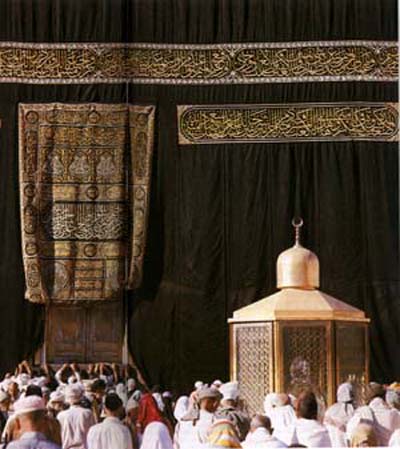
It is opposite the Multazam the only door of the Ka'bah.
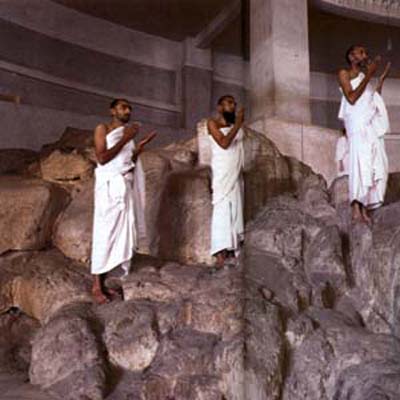
Point of departure for the procession.
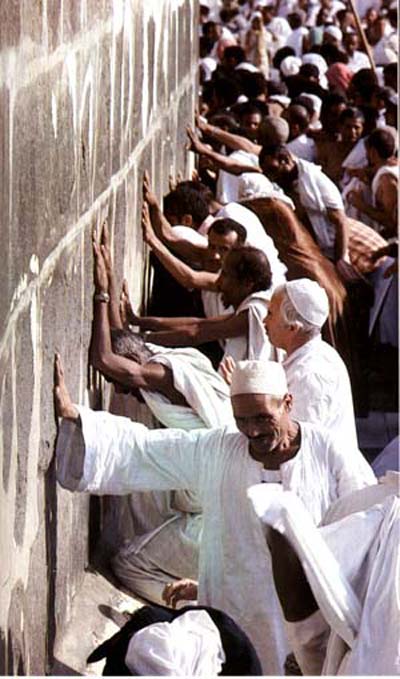
Pilgrims touching one of the walls of the Ka'bah.
Some Muslims are more willing to believe that the Black Stone itself has some supernatural powers. That it fell from the sky during the time of Adam and Eve, and that it has the power to cleanse worshippers of their sins by absorbing them into itself. They say that the Black Stone was once a pure and dazzling white and it has turned black because of the sins it has absorbed over the years.
It is remarkable, however, that even though the temple contained 360 idols worshipped before Muhammad's Prophethood, the black stone was never kissed or made an idol of worship. In fact, the Ka'ba was never worshipped by the idolaters prior to Muhammad's Prophethood. The building contained idols of worship but the building itself was never an object of worship.
The fact that the Ka'ba was rebuilt by Abraham is a historical fact. Since the stone has been there ever since, it stands to reason that Abraham placed the stone in the Ka'ba. The Black Stone is in fact the cornerstone of the Ka'ba and is there as an emblem of the progeny of Abraham which was rejected by the Israelites and became the corner stone of the Kingdom of God.
The Psalms contains a clear reference to it:
While David referred to it as the stone which the builders refused, Jesus spoke of it more plainly in the parable of the husbandman, telling the Israelites that the vineyard, which in the parable stands for the Kingdom of God, would be taken away from them and given to other husbandmen.
That by the rejected stone in the prophecy (21:42) was meant a rejected nation (21:43) is made clear by Jesus Christ. That this rejected nation was none other than the Ishmaelites has been borne out by history.
The Black Stone, therefore, passes for the mithaq, the primordial covenant between the Creator and His created. And in the whole world there is only this unhewn stone, the stone, Cut out of the mountains without hands (Daniel 2:45), and that is the corner-stone of a building, which in point of importance, stands unique in the world.
Touching or kissing the stone has a profound impact on the faithful as it is suppose to count in their favor on judgment day.
The great Muslim traveler from Valencia, Ibn Jubayr (1145-1217) describes the emotion he felt on touching the stone, The stone, when one kisses it, has a softness and freshness which delights the mouth; so much so that he who places his lips upon it wishes never to remove them. It suffices, moreover, that the Prophet said that it is the Right Hand of God on Earth.
The single most important reason for kissing the stone is that Prophet Muhammad did so. No devotional significance whatsoever is attached to the stone. Kissing or touching the Black Stone is a reverential act of acknowledgment that God's hand directed its placement and construction. That Abraham and Muhammad, God's blessing upon them, had touched and kissed the stone and an acknowledgment that God had entrusted the 'corner stone' of His religious central focus for man upon that hollowed and sacred place.
Researchers have noted that the Ka'bah is accurately aligned on two heavenly phenomena - the cycles of the moon and the rising of Canopus, the brightest star after Sirius.
There are various other opinions as to what the Black Stone actually symbolizes. Many Muslims regard the Stone as 'just a stone'. When Umar ibn al-Khattab, the second Caliph, came to kiss the stone, he said, in front of all assembled: "No doubt, I know that you are a stone and can neither harm anyone nor benefit anyone. Had I not seen Allah's Messenger kissing you, I would not have kissed you." They pay their respects to the Black Stone in a spirit of trust in Muhammad, not with any belief in the Black Stone itself.

Annual Hajj Pilgrimage
Sacred Geometry - Creation
The earliest reference we have to a goddess worshipped as a cube-shaped stone is from neolithic Anatolia. Alternatively, 'Kubaba' may mean a hollow vessel or cave - which would still be a supreme image of the goddess. The ideograms for Kubaba in the Hittite alphabet are a lozenge or cube, a double-headed axe, a dove, a vase and a door or gate - all images of the goddess in neolithic Europe.
Deities of other cultures known to have been associated with black stones include Aphrodite at Paphos, Cybele at Pessinus and later Rome, Astarte at Byblos and the famous Artemis/Diana of Ephesus. The latter's most ancient sculpture was, it is said, carved from a black meteorite.
The earliest form of Cybele's name may have been Kubaba or Kumbaba which suggests Humbaba, who was the guardian of the forest in the Epic of Gilgamesh - the world's oldest recorded myth from Assyria of circa 2,500 BCE and, as scholars reveal more of the text as the source of most of the major mythological themes of later civilizations.
The stone associated with Cybele's worship was, originally, probably at Pessinus but perhaps at Pergamum or on Mount Ida. What is certain is that in 204 BCE it was taken to Rome, where Cybele became 'Mother' to the Romans. The ecstatic rites of her worship were alien to the Roman temperament, but nevertheless animated the streets of their city during the annual procession of the goddess's statue. Alongside Isis, Cybele retained prominence in the heart of the Empire until the fifth century BCE - when the stone was then lost. Her cult prospered throughout the Empire and it is said that every town or village remained true to the worship of Cybele.
The home of Aphrodite was at Paphos on Cyprus. Various Classical writers describe the rituals which went on her in her honor - in which a tapering black stone, the object of verneration at her temple, was used.
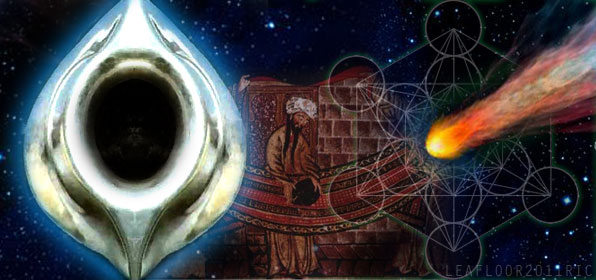
Ancient Alien Theory suggests that the Black Stone is
an alien artifact or at the very least came from space.

Stanley Kubrick uses alchemical allegories through out the film '2001: A Space Odyssey'.
The second main allegory is that it is a black stone that initiates these transmutations. Again this mirrors the alchemical lore about the black stone causing the transmutation of the alchemist. Kubrick proves that he knows exactly what he is doing as his secret is in plain sight.
First one must remember that every time the monolith, the magical stone, appears in the film there is a strange beautiful celestial alignment occurring. And one must remember that every celestial alignment in the film is followed by a monolith, that is, except for one. That would be the lunar eclipse that occurs at the very beginning of the film. So the question arises - if we are to stay within the rules that are prescribed in the rest of the film - where is the monolith that is supposed to follow that first alignment?
The monolith itself doesn't show up in the film for ten more minutes after that first celestial alignment, so what gives here? Is Kubrick just showing off his incredible special effects? Is it just there to impress the viewer from the beginning? These things may very well also be true, but the ultimate trick of Kubrick's is embedded in the idea that the monolith must appear after every one of these magical alignments. Once again, the secret of the film is completely revealed from the beginning. There is a monolith that appears right after the opening sequence with the magical, lunar eclipse. But where is it?
It is right in front of the viewer's eyes! The film is the monolith. In a secret that seems to never have been seen by anyone - the monolith in the film has the same exact dimensions as the Cinerama movie screen on which 2001 was projected in 1968. This can only be seen if one sees the film in it's wide-screen format. Completely hidden, from critic and fan alike, is the fact that Kubrick consciously designed his film to be the monolith, the stone that transforms. Like the monolith, the film projects images into our heads that make us consider wider possibilities and ideas. Like the monolith, the film ultimately presents an initiation, not just of the actor on the screen, but also of the audience viewing the film. That is Kubrick's ultimate trick. He slyly shows here that he knows what he is doing at every step in the process.
The monolith and the movie are the same thing.
- Alchemical Kubrick - 2001: The Great Work On Film - by Jay Weidner
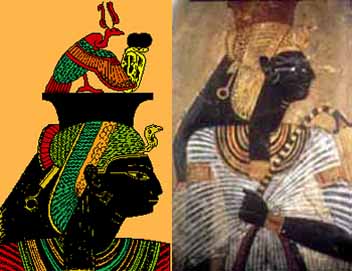
Isis was a magician who is thought to have sometimes used a shiny black stone. Her magic was allied to Thoth and given to mankind as a tool in resurrection after destruction in the alchemy of time. In this regard she is often depicted as black skinned.
- Egyptian Mythology by Richard Patrick
Black Isis was a magician, possibly the archetype for the high priestess of the tarot. She learned her magic from Thoth, although according to some legends she obtained her powers from Ra himself by tricking him into revealing his name to her, thus acquiring his full magical knowledge. The ankh used by Isis with her Initiates may account for some of the oddly-shaped scepters carried by the Black Virgins.
- Murray Hope Practical Egyptian Magic